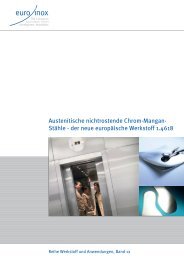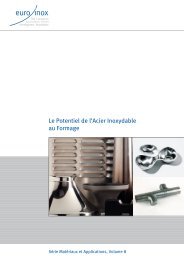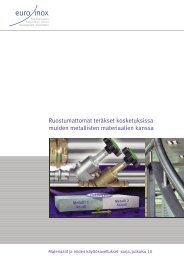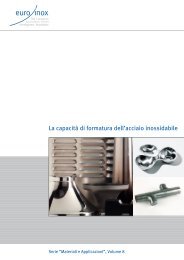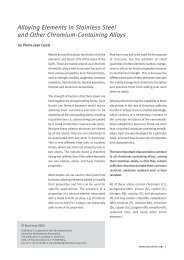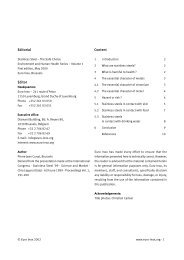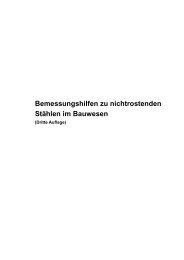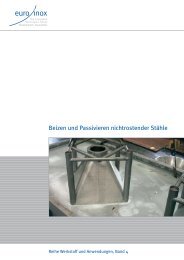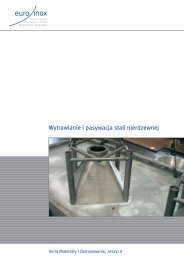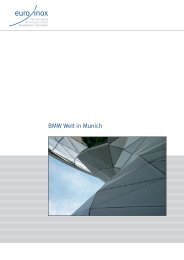Innovative Stainless Steel Applications in transport ... - Euro Inox
Innovative Stainless Steel Applications in transport ... - Euro Inox
Innovative Stainless Steel Applications in transport ... - Euro Inox
Create successful ePaper yourself
Turn your PDF publications into a flip-book with our unique Google optimized e-Paper software.
Table 28. Fusion weld<strong>in</strong>g results for 3.0 mm thick sheet butt jo<strong>in</strong>ts (BUS p. 9). Codes for failure<br />
locations: BM = base material, W = weld metal, HAZ = heat affected zone.<br />
Sample Strength, Elongation 304SP 1.4301 16-7Mn 1.4003<br />
(N/mm 2 ), (%) 2B 2H 2B 2H 2B 2B<br />
BM Rp0.2 347 831 307 590 393 429<br />
Rm 673 977 620 795 695 557<br />
A 51 14 56 30 51 24<br />
MAG Rp0.2 352 514 311 456 395 335<br />
Rm 651 726 626 664 671 452<br />
A 33 3 33 3 26 23<br />
failure W W W W W BM<br />
PPAW Rm 617 722 588 594 703 445<br />
failure W W W W W BM<br />
LBW Rp0.2 333 608 392<br />
Rm 611 892 646 776 501<br />
A50 29 3 25<br />
failure W/BM W<br />
Unlike the 1.5 mm material, 16-7 Mn was only available <strong>in</strong> 2B condition for these<br />
experiments. The results are very similar to the th<strong>in</strong>ner, 1.5 mm material: base-material<br />
strength is reached with all the MAG-welded materials <strong>in</strong> 2B condition and only 1.4003<br />
shows a lower percentage (80 %) compared with previous results. Judged by<br />
percentages, the 3.0 mm cold-rolled material welds appear to reta<strong>in</strong> more of the orig<strong>in</strong>al<br />
base-material strength, but this is ma<strong>in</strong>ly due to the lower base-material strength values.<br />
Also, the fracture modes <strong>in</strong>dicate that weld-metal strength is the govern<strong>in</strong>g factor – and<br />
this obviously rema<strong>in</strong>s the same regardless of sheet thickness. As with th<strong>in</strong>ner materials,<br />
the elongation values of austenitic grades drop considerably <strong>in</strong> welded jo<strong>in</strong>ts. This effect<br />
is most pronounced <strong>in</strong> cold-formed high-strength grades.<br />
The PPAW welds show more or less the same strength levels as with the th<strong>in</strong>ner<br />
material. In some cases, a slight tendency towards an <strong>in</strong>crease <strong>in</strong> strength can be found.<br />
These remarks also apply to laser welds.<br />
Table 29. Lap jo<strong>in</strong>t mechanical test results for 1.5 and 3.0 mm sheet materials (BUS p. 95).<br />
LBW = laser weld<strong>in</strong>g, RSW = resistance spot weld<strong>in</strong>g, ADB = adhesive bond<strong>in</strong>g and<br />
WB = weldbond<strong>in</strong>g.<br />
t Sample Strength 304SP 1.4301 16-7Mn 1.4003<br />
(mm) (N/mm 2 ) 2B 2H 2B 2H 2B 2H 2B<br />
1.5 LBW Rp0.2 187 281 230<br />
Rm 534 570 452 447 417<br />
RSW Rm 152 165 202 225 248 265 97<br />
WB Rm 400 630 375 508 430 475 383<br />
ADB Rm 390 595 370 677 410 620 365<br />
3.0 LBW Rp0.2 179 241 192<br />
91



